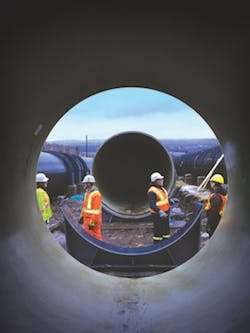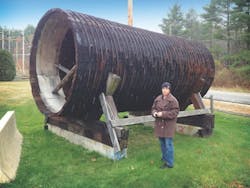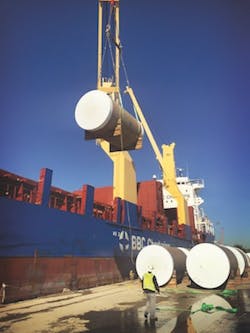About the author: Kimberly Paggioli, P.E., is vice president-marketing and quality control for Hobas Pipe USA. Paggioli can be reached at [email protected].
Hydroelectric penstocks utilize water and elevation to generate electricity. It is a clean, cost-effective and reliable source of energy. Penstocks have been in operation in the U.S. for years, but many installed in the last century are reaching the end of their useful lives. To preserve this environmentally friendly energy generation alternative, rehabilitation projects are underway across the country.
Pumped Storage Facility
One such penstock located in Connecticut is used to store energy. An 8-sq-mile storage area is filled by pumping water from the river during periods when electricity is least expensive. When electricity demand reaches a peak, water is released through the same penstock, and the motors driving the pumps reverse to generate electricity.
The penstock transports water between Candlewood Lake, the upper reservoir, and the plant’s surge tank above the Housatonic River, the lower reservoir, by means of the Rocky River plant, which is owned by First Light Power. Candlewood Lake, named for nearby Candlewood Mountain, is the largest man-made lake in the state.
Like many older penstocks, Rocky River was a wood stave pipeline. The original penstock, which operated from 1928 to 1965, was made of Douglas fir held in place by iron rings. In 1965, the penstock was replaced by another made of the same materials. Again, it outlived its useful life and the owner and engineers looked for another solution.
The next project went out to bid in January 2012 for roughly $3 million. This time, the solution was a centrifugally cast, fiber-reinforced polymer mortar (CCFRPM) pipe manufactured by Hobas Pipe USA. The company supplied 950 ln ft of 120-in.-diameter CCFRPM pipe that included three miter joints to navigate directional changes. The pipe was manufactured with a stiffness class of 36 psi and pressure class of 26 psi. The pipe provided a structurally sound replacement, eliminated leaking joints and requires little maintenance.
“The 15-ft-diameter wood stave penstock leak resulted in safety concerns, and costly maintenance had become time consuming and [cost] prohibitive,” said Jillian Davis, P.E., of Kleinschmidt Associates’ Pittsfield, Maine office. “The final configuration consisted of a 10-ft-diameter [fiberglass reinforced pipe (FRP)] with an estimated service life at least equal to steel but with less maintenance.”
Kimberly Paggioli stands with a piece of the original decommissioned wood stave Jackman Penstock. Wood penstocks were a common building material in the last century.
Reducing Head Loss
Another penstock can be found meandering through the White Mountains of New Hampshire. This large wooden penstock served as the main water supply for a local hydro facility called Jackman Station. It is fed by the Franklin Pierce Reservoir, which was created by the Jackman Station’s dam and surrounding earthen dikes. The water elevation in the reservoir is managed by spring runoff.
This facility, located in Hillsborough, N.H., has served the area for years, but the penstock was approaching the end of its service life.
Prior to recent improvements, 5,000 ft of wood stave penstock extended from the Franklin Pierce reservoir to a surge tank upstream of the powerhouse. This 7.5-ft-diameter penstock was made up of vintage wood stave sections, circa 1926. Repairs were made in 1954 and again in the 1970s, yet the downstream sections of the wood penstock still leaked badly. This leak iced over in the winter and required constant maintenance. In 2003, the penstock ruptured and affected neighboring properties. To prevent future failures and ensure reliable operation of the hydro facility, repairs to the existing penstock were necessary. In a series of contracts, Public Service of New Hampshire, the current owner, replaced the remaining wood stave penstock with a new pipeline.
“The corrosion resistance and relative stiffness of FRP meant it could be supported on the existing grade and half buried, rather than placed on saddles or completely covered in a buried trench,” said Keith Martin, project engineer, civil and structural engineer for Kleinschmidt’s Pittsfield office. “This design flexibility, combined with a longer projected service life, led to a competitive total construction cost for the FRP alternative,”
The lower frictional resistance of the FRP allowed for the replacement pipe to be reduced to a 7-ft-diameter replacement pipe without additional head loss.
After evaluating the finished project, Martin said he found using fiberglass pipe to be seven times cheaper per foot to partially backfill the penstock than to support it above ground. Hydraulic advantages and longevity of the line also provide savings. Water & Mountains Penstocks are largely found in areas conducive to moving fresh water vertically, making penstocks commonplace in mountainous regions. On the island of Newfoundland, Canada, the far northern reaches of the Appalachian Mountains display the typical southwest to northeast alignment with bays, peninsulas, river systems and mountain ranges. The island is home to many penstocks. Because of the humid climate and plentiful snowfall, the water table is quite high. Its lakes are usually full and rivers flow perennially.
Newfoundland & Labrador Hydro is an electricity generation company in Newfoundland and Labrador, Canada. Its installed generating capacity is 1,792 MW, and more than 80% of the energy it generates is hydroelectric.
The wood stave penstock located at Pierre’s Brook Hydroelectric Development has reached the end of its useful life. For the replacement line, 8,000 ft of 72-in. CCFRPM pipe and fittings were manufactured in Houston and transported by cargo ship on a 10-day journey to Bay Bulls, Newfoundland, Canada.
8,000 ft of 72-in. Hobas pipe was shipped from Houston, Texas and transorted by cargo ship in a 10-day journey to Bay Bulls, Newfoundland, Canada.
Also in Newfoundland, Corner Brook Pulp and Paper Ltd. and its parent company, Kruger Inc., will spend $8.1 million to replace one of the nine penstocks at the hydroelectric power plant this summer.
As electrical demand increases, penstocks will continue to provide environmentally friendly means of energy generation in areas conducive to its use. According to the “2014 Hydropower Market Report” by the U.S. Department of Energy, “Overall, the size of the U.S. hydropower fleet has continued to grow over the last decade as owners optimize and upgrade existing assets. Despite some retirements, U.S. hydropower capacity increased by nearly 1.5 GW from 2005 to 2013. For those new projects that have been constructed during that time, only four—out of more than 100—were not associated with existing water infrastructure.
“Instead, the industry has focused on opportunities to develop hydropower on existing pieces of water infrastructure at non-powered dams and conduits. These types of projects, along with dozens of new large-scale pumped storage hydropower projects that are being pursued, dominate the current development pipeline.”


